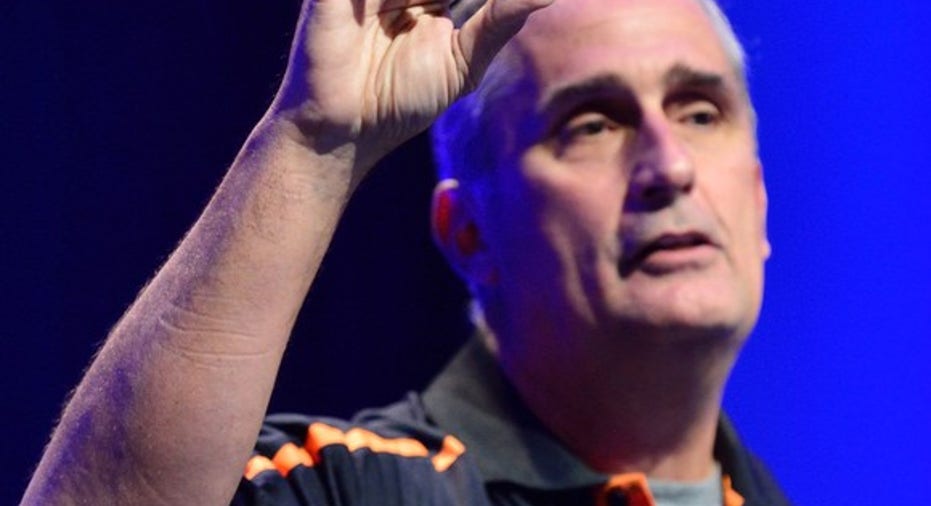3 Ways Intel Corporation Has Changed in 3 Years

Over the past three years or so, chip giant Intel (NASDAQ: INTC) has been undergoing a significant transformation as the world around it has changed. The rise of smartphones and tablets, particularly as they have become powerful enough to handle tasks that were once only possible on personal computers, has negatively affected demand for notebook and desktop computers -- Intel's largest revenue source.
Intel CEO Brian Krzanich holding an Intel Stratix 10 FPGA. Image source: Intel.
Let's look at three ways Intel has changed in that time, as the company's ongoing transformation should be of utmost interest to current and potential Intel investors.
Losses from mobile devices have fallen dramatically
In 2013, Intel's Mobile and Communication Group (MCG), which builds chips aimed at devices such as smartphones and tablets, posted a $3.148 billion loss. Those losses expanded to around $4.2 billion during 2014 as the company began providing "contra-revenue" payments to its tablet processor customers for each Intel-powered tablet sold.
Those payments, per Intel, were meant to offset the increased system-level costs associated with using Intel's Bay Trail chips relative to competing tablet platforms.
Intel's Atom processors had a tough time competing with chips from rival chipmakers in the smartphone and tablet market. Image source: Intel.
Since then, Intel has been working to bring those losses down through several actions, including a reduction in contra-revenue, as its tablet processor shipments declined and the company improved the cost structures of its tablet platforms, and a significant reduction in operating expenses -- in other words, cutting or ending investments in future mobile products.
The net result is that those losses dropped by "almost a billion" in 2015 -- note that Intel stopped breaking out MCG results in its earnings releases in early 2015 -- and the company said that it expects to improve that figure by $800 million, though CEO Brian Krzanich said a couple of quarters ago that the company will "shoot to do better than that."
If we assume the mobile losses came down by $950 million in 2015, and by another $800 million in 2016, then the company should close out the year with those losses down to under $2.5 billion for the year.
Since Intel's MCG and PC Client Group businesses have been merged into the new Client Computing Group, or CCG, any further improvement in the mobile-related losses will show up as an improvement in the operating profit of CCG -- Intel's largest business unit.
Intel has embraced contract chip manufacturing work
Before 2013, under previous CEO Paul Otellini, the company wasn't too keen on becoming a "general-purpose foundry" -- in other words, it didn't want to do contract chip manufacturing work for just any company.
Intel's Fab 32 chip manufacturing facility. Image source: Intel.
In an interview conducted by Semiconductor Engineering in late 2012, Intel senior fellow Mark Bohr had the following to say about the company's strategy vis-a-vis contract chip manufacturing: "It's not Intel's goal to be a general-purpose foundry, but we will be partnering where it makes strategic sense."
Then, when Krzanich took the reins as CEO, the company's tune changed dramatically, with stated plans in a late 2013 investor meeting for an "open foundry to any company able to utilize [Intel's] leading-edge silicon."
Since then, Intel has forged partnerships with ARM Holdings, other semiconductor intellectual-property vendors, and electronic design automation tool vendors to enable a broader range of customers to build chips on its manufacturing technologies.
Intel's foundry business doesn't generate much in the way of revenue today, but the company seems very intent on opening this up as a potential source of significant revenue. It takes a long time from design wins to revenue, but in three years we'll have a better idea of how much progress Intel is making here.
Diversification away from the personal-computer market
Although Intel has historically generated a very large portion of its revenue from sales of chips into personal computers, and thus has real incentive to make sure it can keep its revenues and profits here as high as possible, the reality is that the company can't count on this segment for sustainable, long-term revenue growth.
To that end, the company has worked to grow its other business segments, such as the data center, the Internet of Things, programmable logic devices, and flash memory in an attempt to reduce its reliance on the personal-computer market.
Intel's latest personal computer processor -- Kaby Lake. Image source: Intel.
In 2013, Intel's CCG represented 66% of the company's total revenue, per the company's 2015 annual report; that figure came down to 58% in 2015. In 2016, that figure is likely to come down further, as CCG is expected to decline while many of its other segments -- especially its large data-center group, accounting for about 29% of revenue in 2015 -- grow year over year.
Although Intel isn't immune to declines in the personal-computer market, considering that more than half of the company's revenue still comes from it, its other businesses are in increasingly better shape to offset modest declines there going forward.
A secret billion-dollar stock opportunity The world's biggest tech company forgot to show you something, but a few Wall Street analysts and the Fool didn't miss a beat: There's a small company that's powering their brand-new gadgets and the coming revolution in technology. And we think its stock price has nearly unlimited room to run for early in-the-know investors! To be one of them, just click here.
Ashraf Eassa owns shares of Intel. The Motley Fool recommends Intel. Try any of our Foolish newsletter services free for 30 days. We Fools may not all hold the same opinions, but we all believe that considering a diverse range of insights makes us better investors. The Motley Fool has a disclosure policy.



















